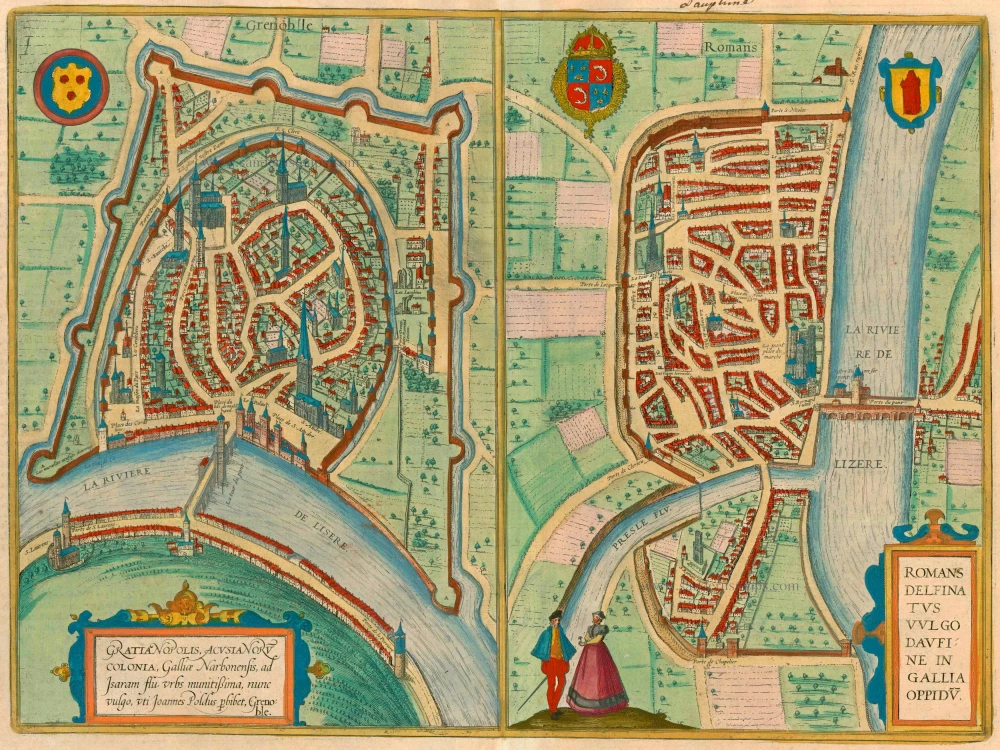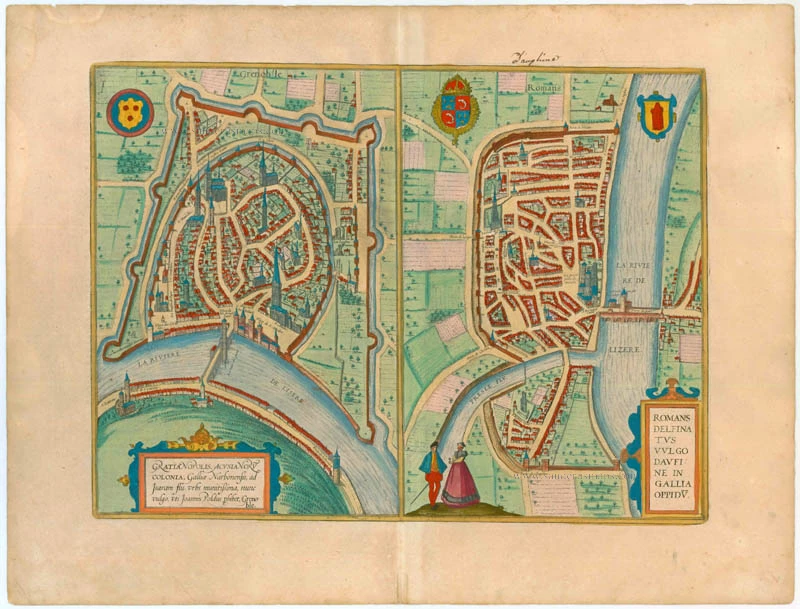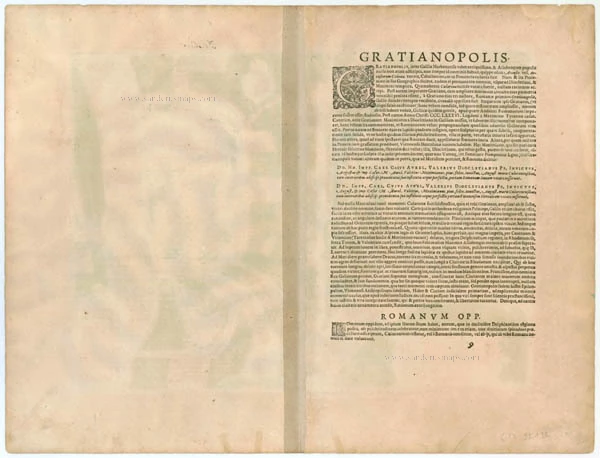Grenoble and Romans-sur-Isère, by Georg Braun and Frans Hogenberg. 1581-88
GRENOBLE
TRANSLATION OF CARTOUCHE TEXT: Gratianopolis, a colony of Acusiana or Acusianorum Colonia, a formidably fortified city in Gallia Narbonensis, on the Isère, today called Grenoble.
COMMENTARY BY BRAUN: "Its ancient shape is more elongated than wide; it tapers towards a point and assumes the overall shape of an egg. Lying on level ground at the foot of the mountains, it extends towards the east ...; the Isère, which flows down from the tops of the Swiss mountains to the east, runs through the city. Toward the north, a beautiful bridge leads over the Isère to the suburb called St Lawrence."
Grenoble, situated at the foot of the French Alps, is seen from an elevated viewpoint from the north. As Braun describes it, the city is protected by an egg-shaped inner and rectangular outer city wall. Numerous churches and towers, their verticals greatly exaggerated, dominate the cityscape; they include the 12th-century cathedral of Notre Dame in the background and, in the foreground, the collegiate church of Saint-André. The Palace of Justice is facing the latter, with several towers directly overlooking the river. The city was purportedly renamed Gratianopolis in AD 377 in honour of Emperor Gratian.
ROMANS-SUR-ISÈRE
CARTOUCHE: Romans delfinatus, also Daufine, a city in Gaul.
COMMENTARY BY BRAUN: "The small town of Romans lies directly beside the Isère and is famous for its beauty amongst the cities in the lower reaches of the Dauphiné. Its name is also evidence that it was built either by the Romans or those of Roman descent."
As apparent both from the vertical-format bird's-eye view and from the modern-day name of the town, Romans lies on the River Isère, a tributary of the Rhône. Situated near the Vercors Mountains, the town arose in the 9th century AD in the wake of the founding of an abbey. It has already expanded beyond its historical boundary and the river in the present engraving. The originally Romanesque collegiate church of Saint-Bernard (12th/13th cent.) is located between the large market square (centre) and the river's edge, behind the church attached to the palace of the Vienne archbishops; situated on the bridge on the right is Notre-Dame-sur-le-Pont. (Taschen)
The two plans are made after plans published by Belleforest in his La Cosmographie Universelle. Paris, 1575.
Braun G. & Hogenberg F. and the Civitates Orbis Terrarum.
The Civitates Orbis Terrarum, also known as the 'Braun & Hogenberg', is a six-volume town atlas and the most excellent book of town views and plans ever published: 363 engravings, sometimes beautifully coloured. It was one of the best-selling works in the last quarter of the 16th century. Georg Braun, a skilled writer, wrote the text accompanying the plans and views on the verso. Many plates were engraved after the original drawings of a professional artist, Joris Hoefnagel (1542-1600). The first volume was published in Latin in 1572 and the sixth in 1617. Frans Hogenberg, a talented engraver, created the tables for volumes I through IV, and Simon van den Neuwel made those for volumes V and VI. Other contributors were cartographers Daniel Freese and Heinrich Rantzau, who provided valuable geographical information. Works by Jacob van Deventer, Sebastian Münster, and Johannes Stumpf were also used as references. Translations appeared in German and French, making the atlas accessible to a broader audience.
Since its original publication of volume 1 in 1572, the Civitates Orbis Terrarum has left an indelible mark on the history of cartography. Seven more editions followed the first volume in 1575, 1577, 1582, 1588, 1593, 1599, and 1612. Vol.2, initially released in 1575, saw subsequent editions in 1597 and 1612. The subsequent volumes, each a treasure trove of historical insights, graced the world in 1581, 1588, 1593, 1599, and 1606. The German translation of the first volume, a testament to its widespread appeal, debuted in 1574, followed by the French edition in 1575.
Several printers were involved: Theodor Graminaeus, Heinrich von Aich, Gottfried von Kempen, Johannis Sinniger, Bertram Buchholtz, and Peter von Brachel, all of whom worked in Cologne.
Georg Braun (1541-1622)
Georg Braun, the author of the text accompanying the plans and views in the Civitates Orbis Terrarum, was born in Cologne in 1541. After his studies in Cologne, he entered the Jesuit Order as a novice, indicating his commitment to learning and intellectual pursuits. In 1561, he obtained his bachelor's degree; in 1562, he received his Magister Artium, further demonstrating his academic achievements. Although he left the Jesuit Order, he continued his studies in theology, gaining a licentiate in theology. His theological background likely influenced the content and tone of the text in the Civitates Orbis Terrarum, adding a unique perspective to the work.
Frans Hogenberg (1535-1590)
Frans Hogenberg was a Flemish and German painter, engraver, and mapmaker. He was born in Mechelen as the son of Nicolaas Hogenberg.
By the end of the 1560s, Frans Hogenberg was employed upon Abraham Ortelius's Theatrum Orbis Terrarum, published in 1570; he is named an engraver of numerous maps. In 1568, he was banned from Antwerp by the Duke of Alva and travelled to London, where he stayed a few years before emigrating to Cologne. He immediately embarked on his two most important works, the Civitates, published in 1572 and the Geschichtsblätter, which appeared in several series from 1569 until about 1587.
Thanks to large-scale projects like the Geschichtsblätter and the Civitates, Hogenberg's social circumstances improved with each passing year. He died as a wealthy man in Cologne in 1590.
Gratianopolis Acusianoru Colonia, ... [on sheet with] Romans Delfinatus vulgo Daufine in Gallia Oppidu.
Item Number: 22192 Authenticity Guarantee
Category: Antique maps > Europe > France - Cities
Old, antique bird’s-eye view plan of Grenoble and Romans-sur-Isère, by Georg Braun and Frans Hogenberg.
Title: Gratianopolis Acusianoru Colonia, ... [on sheet with] Romans Delfinatus vulgo Daufine in Gallia Oppidu
Date: 1581-88.
Copper engraving, printed on paper.
Size (not including margins): 325 x 435mm (12.8 x 17.13 inches).
Verso: Latin text.
Condition: Superb old colour, excellent.
Condition Rating: A+.
From: Civitates Orbis Terrarum. . Liber tertius. Köln, G. Kempen, 1581-88. (Koeman, B&H3)
GRENOBLE
TRANSLATION OF CARTOUCHE TEXT: Gratianopolis, a colony of Acusiana or Acusianorum Colonia, a formidably fortified city in Gallia Narbonensis, on the Isère, today called Grenoble.
COMMENTARY BY BRAUN: "Its ancient shape is more elongated than wide; it tapers towards a point and assumes the overall shape of an egg. Lying on level ground at the foot of the mountains, it extends towards the east ...; the Isère, which flows down from the tops of the Swiss mountains to the east, runs through the city. Toward the north, a beautiful bridge leads over the Isère to the suburb called St Lawrence."
Grenoble, situated at the foot of the French Alps, is seen from an elevated viewpoint from the north. As Braun describes it, the city is protected by an egg-shaped inner and rectangular outer city wall. Numerous churches and towers, their verticals greatly exaggerated, dominate the cityscape; they include the 12th-century cathedral of Notre Dame in the background and, in the foreground, the collegiate church of Saint-André. The Palace of Justice is facing the latter, with several towers directly overlooking the river. The city was purportedly renamed Gratianopolis in AD 377 in honour of Emperor Gratian.
ROMANS-SUR-ISÈRE
CARTOUCHE: Romans delfinatus, also Daufine, a city in Gaul.
COMMENTARY BY BRAUN: "The small town of Romans lies directly beside the Isère and is famous for its beauty amongst the cities in the lower reaches of the Dauphiné. Its name is also evidence that it was built either by the Romans or those of Roman descent."
As apparent both from the vertical-format bird's-eye view and from the modern-day name of the town, Romans lies on the River Isère, a tributary of the Rhône. Situated near the Vercors Mountains, the town arose in the 9th century AD in the wake of the founding of an abbey. It has already expanded beyond its historical boundary and the river in the present engraving. The originally Romanesque collegiate church of Saint-Bernard (12th/13th cent.) is located between the large market square (centre) and the river's edge, behind the church attached to the palace of the Vienne archbishops; situated on the bridge on the right is Notre-Dame-sur-le-Pont. (Taschen)
The two plans are made after plans published by Belleforest in his La Cosmographie Universelle. Paris, 1575.
Braun G. & Hogenberg F. and the Civitates Orbis Terrarum.
The Civitates Orbis Terrarum, also known as the 'Braun & Hogenberg', is a six-volume town atlas and the most excellent book of town views and plans ever published: 363 engravings, sometimes beautifully coloured. It was one of the best-selling works in the last quarter of the 16th century. Georg Braun, a skilled writer, wrote the text accompanying the plans and views on the verso. Many plates were engraved after the original drawings of a professional artist, Joris Hoefnagel (1542-1600). The first volume was published in Latin in 1572 and the sixth in 1617. Frans Hogenberg, a talented engraver, created the tables for volumes I through IV, and Simon van den Neuwel made those for volumes V and VI. Other contributors were cartographers Daniel Freese and Heinrich Rantzau, who provided valuable geographical information. Works by Jacob van Deventer, Sebastian Münster, and Johannes Stumpf were also used as references. Translations appeared in German and French, making the atlas accessible to a broader audience.
Since its original publication of volume 1 in 1572, the Civitates Orbis Terrarum has left an indelible mark on the history of cartography. Seven more editions followed the first volume in 1575, 1577, 1582, 1588, 1593, 1599, and 1612. Vol.2, initially released in 1575, saw subsequent editions in 1597 and 1612. The subsequent volumes, each a treasure trove of historical insights, graced the world in 1581, 1588, 1593, 1599, and 1606. The German translation of the first volume, a testament to its widespread appeal, debuted in 1574, followed by the French edition in 1575.
Several printers were involved: Theodor Graminaeus, Heinrich von Aich, Gottfried von Kempen, Johannis Sinniger, Bertram Buchholtz, and Peter von Brachel, all of whom worked in Cologne.
Georg Braun (1541-1622)
Georg Braun, the author of the text accompanying the plans and views in the Civitates Orbis Terrarum, was born in Cologne in 1541. After his studies in Cologne, he entered the Jesuit Order as a novice, indicating his commitment to learning and intellectual pursuits. In 1561, he obtained his bachelor's degree; in 1562, he received his Magister Artium, further demonstrating his academic achievements. Although he left the Jesuit Order, he continued his studies in theology, gaining a licentiate in theology. His theological background likely influenced the content and tone of the text in the Civitates Orbis Terrarum, adding a unique perspective to the work.
Frans Hogenberg (1535-1590)
Frans Hogenberg was a Flemish and German painter, engraver, and mapmaker. He was born in Mechelen as the son of Nicolaas Hogenberg.
By the end of the 1560s, Frans Hogenberg was employed upon Abraham Ortelius's Theatrum Orbis Terrarum, published in 1570; he is named an engraver of numerous maps. In 1568, he was banned from Antwerp by the Duke of Alva and travelled to London, where he stayed a few years before emigrating to Cologne. He immediately embarked on his two most important works, the Civitates, published in 1572 and the Geschichtsblätter, which appeared in several series from 1569 until about 1587.
Thanks to large-scale projects like the Geschichtsblätter and the Civitates, Hogenberg's social circumstances improved with each passing year. He died as a wealthy man in Cologne in 1590.







